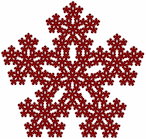A couple of days ago I got an email from my long-time friend Geri, who was spending some quality Sketchpad time with her 12-year-old grandson Niels. Geri emailed me for advice because Neils was having some trouble figuring out how to construct a pentaflake. Neither Geri nor Niels had any idea that I’d never even heard of a pentaflake, let alone constructed one.
 I couldn’t let Niels down, so off I went to MathWorld to bring myself up to flake speed. Whew, there were a lot of formulas there! Fortunately there was also a clear picture: dissect a regular pentagon to make six smaller pentagons, one at each vertex and one in the space that’s left in the interior. I used Sketchpad to build a pentagon and played around with a variety of constructions, and then had a breakthrough when I realized that the edges of the inner pentagon lie on the diagonals of the original large pentagon. Eureka — inscribe a star in the pentagon and you’ve located the five inner vertices of the pentaflake! With a bit more thought, I realized that those five inner vertices are sufficient: they determine all 6 of the small pentagons, so that’s all I needed to create the fractal iteration.
I couldn’t let Niels down, so off I went to MathWorld to bring myself up to flake speed. Whew, there were a lot of formulas there! Fortunately there was also a clear picture: dissect a regular pentagon to make six smaller pentagons, one at each vertex and one in the space that’s left in the interior. I used Sketchpad to build a pentagon and played around with a variety of constructions, and then had a breakthrough when I realized that the edges of the inner pentagon lie on the diagonals of the original large pentagon. Eureka — inscribe a star in the pentagon and you’ve located the five inner vertices of the pentaflake! With a bit more thought, I realized that those five inner vertices are sufficient: they determine all 6 of the small pentagons, so that’s all I needed to create the fractal iteration.
So here’s the sketch I sent back to Niels, in three pages. Page 1 describes the dissection, with buttons to illustrate each of the steps. Page 2 gives detailed instructions on doing the iteration, which requires some care to create the six maps that define the dissection. (Note that you can’t create the iteration right here on this web page; you must do so in Sketchpad itself.) And page 3 shows the resulting pentaflake in all its glory. (Drag points A or B right here on the web page, or edit the desired-depth parameter.)
With the help of the hints on pages 1 and 2, Niels was able to construct his pentaflake, and I encourage you to do the same. Notice on page 2 that I used a depth parameter so I could easily change the depth of iteration that’s displayed. (I limited how great a depth you can use — this construction grows quickly. By depth 5 you’re nearing 10,000 pentagons, and by depth 8 you have well over a million, which will slow your computer down just a tad.)
It’s better, of course, to construct your own pentaflake, but if you like you can download mine. (And even if you don’t have Sketchpad, you can get the free trial version and use it to do your own construction or to play with mine.)
Neat post. Here’s a related chaos game rendering of the pentaflake (and others).
Image.
Live version is found here.
Thanks, Dan, for pointing out the Chaos Game connection; I really like that web page. I’d never heard of the Processing language before, and it looks very interesting.
Your comment made me say to myself, “Of course, what a good idea! I’ve taught Sketchpad to play the Chaos Game with triangles, and that was fun. So why not show how to play the Chaos game with a pentagon?” So I just posted it here.
How very inclusive and kind of you to share that you came full circle from “What’s that?” to constructing a pentaflake of your very own. Always approachable! Thank you, Scott.